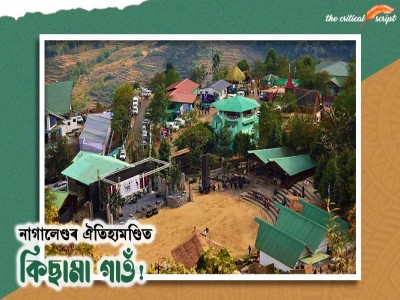
Arunachal Pradesh: Transition of Infrastructure and Livelihood
Being a hilly region, Arunachal Pradesh has had general
developmental challenges and constraints, but the government has sought to
reform the state in recent years, and the changes that have been made have been
noticed and appreciated by both state residents and those outside the region.
The state has recently been adjudged the "Most Improved Small State in Infrastructure and Governance" based on a survey conducted by India Today in the State of States Conclave 2021. The honour was given to the State administration in appreciation for their efforts in the socio-economic sectors of infrastructure and governance. As well as, Arunachal Pradesh bagged three best awards under Pradhan MantriAwasYojana-Urban (PMAY-U) Awards 2022: for conducting Information, Education, and Communication (IEC) activities, for exemplary performance in the implementation of Pradhan MantriAwasYojana-Urban (Urban) scheme, and the 'Best Performing Nagar Panchayat' among North Eastern & hilly states to Tawang district (2nd rank) at the Indian Urban Housing Conclave-2022” held at Rajkot in Gujarat.
The initiative to connect the vast areas of Arunachal is taking shape, from rail connectivity to road connectivity to the first full-fledged Greenfield Airport (Donyi Polo Airport, Itanagar). There are currently train and plane connections to the state capital Itanagar; and all foothill regions of the state, including high-altitude regions like Tawang, Upper Subansiri, Anjaw, etc. are being surveyed for rail and air connectivity. With access to railway connections and the latest advancement in air connectivity across the state under the UDAN scheme, and the inauguration of the state's first Greenfield airport, visitors can now effortlessly travel to Arunachal Pradesh as well as native citizens can move outside their particular regions easily.
In terms of road connectivity, about 85% of road connectivity works have been completed under the Trans Arunachal highway stretching over 1800 km and under the Pradhan Mantri Gram SadakYojana (PMGSY), and high-quality road connection is reaching remote villages of the state. Reports say that Arunachal Pradesh has the highest ratio of road length to vehicle length among all Indian states, with 210.5 km of roads accessible for every 1,000 automobiles. Under PMGSY, the road from BRTF road to Riga Hq. (8.22 km) and the road from Jomlo Bari to JomloMobuk Stage-II (3.92 km) amongst many has been inaugurated. Projects to interconnect within the region including a double lane RCC bridge over river Kabung on Dosing-Yibuk road (span: 45.00 mtr + 15.00 mtr viaduct) and a steel bridge adjoining Rigo and Nimte villages in the Papum Pare district amidst the multiple major development projects have also been covered.
Arunachal Pradesh is also pushing forward with numerous hydropower projects such as the run-of-the-river Pare Hydro Power Plant in Papum Pare District, which was built to harness the hydropower of the Dikrong River (a tributary of the Brahmaputra). The 405 MW Ranganadi Hydro Power Station's tailrace discharge is also used by the station. The plant has a 110 MW installed capacity, an 824 sq. km catchment area, and a 67.36 m design head as well as the powerhouse of the Kameng Hydro Power Station, located in Kimi, West Kameng District, Arunachal Pradesh, is another run-of-the-river project to harness the hydropower of the Bichom and Tenga Rivers, both of which are tributaries of the River Kameng. One dam is located in Bichom while the other is located at Tenga in the power plant. With a catchment area of 2277 square kilometres (Bichom) and 1019 square kilometres (Tenga) and a design head of 504 metres, the Station has a 600 MW installed capacity. In addition to producing energy, hydropower also provides flood control, agriculture support, and clean drinking water. It has a low cost compared to other energy sources and offers cheap electricity along with long-term durability. Above mentioned are only two examples, but many hydropower projects have been completed, several are on the verge of completion, and some mega hydropower projects are being surveyed for establishment in the state of Arunachal Pradesh.
In terms of the infrastructure development and citizens' convenience of Arunachal Pradesh in recent years, many efforts are being made in different sectors such as to streamline health infrastructure and capacity building: 18 district hospitals are being upgraded with Rs 250 Cr and 60 identified Private Healthcare Systems (PHCS) and Community Health Centres (CHCs) are also in the process of upgradation. The BakinPertin General Hospital, Pasighat, is being elevated to 300 beds, and the upgradation of the 40-bed district hospital with a maternal and child wing at Doimukh for Rs 10 Cr. Also, casualty rooms in all general and district hospitals are being converted into state-of-the-art 'emergency care centres.' Also, to boost infrastructure and improve education quality in Arunachal Pradesh, several model schools have already been established across the state and more efforts are being made by the state government including an amount of Rs 50 Cr that has been set aside for the establishment of model schools throughout the state, aboutRs 10 Cr have been sanctioned to improve the infrastructure of Sainik School's permanent campus in East Siang, and a financial boost of Rs. 500 Cr to 12 Eklavya Model Residential Schools and 8 Model Residential Schools have been made.
In a nutshell, the government of Arunachal Pradesh has been
actively working towards the advancement of the region and ease of living for
the netizens. Several projects drafted in a paper, have been made a reality and
we are all witness to the immense transition the state has shown from its
maiden voyage of attaining statehood on February 20, 1987.
In order to become independent of Central financing for state development, the state's revenue has increased from Rs 900 Cr in 2015–16 to Rs 2100 Cr in 2018–19. According to the India Brand Equity Foundation, GoI, Arunachal's GSDP is estimated to reach Rs. 29,372 Cr in 2022-23.The improvement of revenue creation and favourable livelihood of the citizens is Arunachal Pradesh's main priority. And in no time, the region will have greatly contributed towards the creation of the New India vision by becoming self-reliant and independent of the centre's funding.
Disclaimer: The opinions expressed in this article are those of the author's. They do not purport to reflect the opinions or views of The Critical Script or its editor.

Newsletter!!!
Subscribe to our weekly Newsletter and stay tuned.

















Related Comments